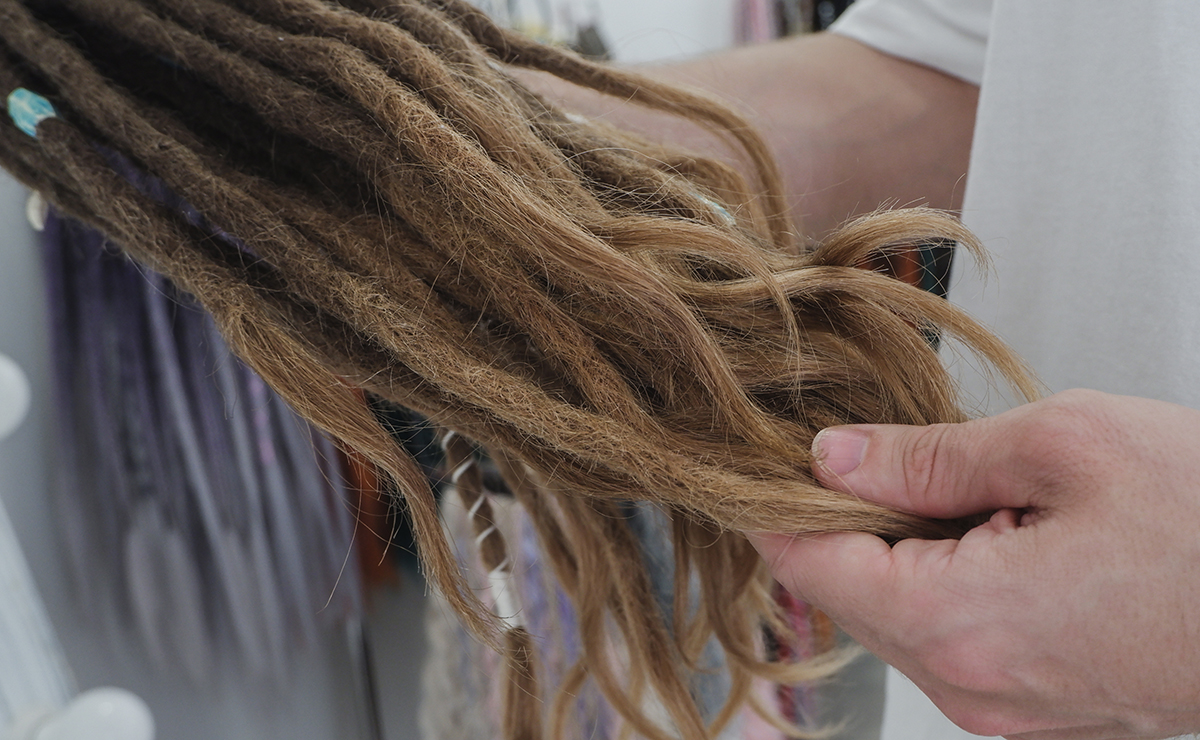Dreadlocks are a unique and expressive hairstyle that allows for creativity and individuality. Whether you’re drawn to the natural, carefree look or the cultural significance, starting dreadlocks with your own natural hair can be a fulfilling journey. In this guide, we’ll cover everything you need to know to get started with dreadlocks, from choosing the right dreadlock style and understanding the process to learning about essential care routines. Let’s dive in!
Understanding Dreadlocks and Preparing Your Hair
Before diving into the techniques, it’s crucial to understand what makes dreadlocks special and how to prepare your hair for the journey. Dreadlocks are more than just a hairstyle; they’re an art form, representing patience, commitment, and sometimes cultural heritage.
Preparing Your Natural Hair for Dreadlocks
Starting dreadlocks with natural hair begins with proper preparation. Here are the steps to ensure your hair is ready:
- Cleanse Your Hair Thoroughly – Before beginning, wash your hair with a clarifying shampoo to remove oils, dirt, and any residue. Avoid conditioning products, as they can soften hair too much, making it harder to lock.
- Avoid Oils and Conditioners – While conditioners are great for everyday hair care, they’re not ideal for starting dreadlocks. Oils and conditioners can make your hair slippery, which prevents the natural tangling that forms dreads.
- Hair Length Requirement – Ideally, your hair should be at least 6-8 cm (2-3 inches) long to start dreadlocks. Shorter hair can be challenging to lock and may not hold well. Longer hair gives more flexibility with size and thickness.
Choosing Your Dreadlock Style
Dreadlocks come in many styles, each offering a distinct look and feel. Here are the main types of natural dreadlocks and how to choose one that suits your preferences:
- Traditional Dreadlocks – Made with a comb and crochet hook, traditional dreadlocks are uniform and compact, with a neat, even appearance. These are versatile and suitable for various hair types, offering a long-lasting, professional look.
- Freeform Dreadlocks – With minimal manipulation, freeform dreads allow the hair to lock naturally. They’re low-maintenance and require no tools, but the look can be unpredictable, with different sizes and textures.
- Sisterlocks – Very thin, highly flexible dreads often seen with Afro-textured hair. This method can involve 100+ dreadlocks on a single head, creating a dense, natural look.
Once you’ve chosen your style, it’s time to understand the actual process of creating dreadlocks.
Methods for Creating Dreadlocks with Natural Hair
There are multiple techniques for creating dreadlocks, each with unique benefits. We’ll explore the most popular methods for natural hair and how to use them effectively.
Backcombing Method
Backcombing is one of the most reliable techniques for forming dreadlocks, ideal for medium to long hair.
- Divide the Hair – First, section the hair into squares based on your desired dreadlock thickness. Generally, a 2×2 cm section will create medium dreads, while 1×1 cm will form thin ones.
- Tease the Hair – Take each section and comb the hair towards the scalp. Insert the comb near the root, pull it out slightly, and repeat the motion along the strand. This will create a tangled shaft.
- Use a Crochet Hook – A small crochet hook, ideally 0.4-0.45 mm, is essential for tightening each lock. Insert the hook into the section and pull stray hairs inward to form a tight dreadlock.
- Roll the Dreads – Roll each dread between your palms to solidify its shape. Palm rolling helps the hair lock together naturally.
Freeform Method
For those who prefer a natural look with minimal maintenance, freeform dreadlocks are the way to go.
- Let Your Hair Lock Naturally – With freeform dreads, allow your hair to lock on its own without any tools. Wash your hair regularly but avoid combing or using any products that might prevent tangling.
- Daily Strand Separation – As your hair begins to tangle, separate the strands into sections by gently pulling apart knots. This will ensure each lock forms individually.
- Palm Roll for Control – Palm rolling helps keep dreads from becoming too bulky. While freeform dreads embrace natural irregularities, some light palm rolling can offer a bit of control.
Maintaining Natural Dreadlocks
After you’ve created your dreadlocks, it’s essential to maintain them properly to ensure they remain clean, healthy, and well-formed.
Washing Dreadlocks
Keeping dreadlocks clean is crucial for their longevity and hygiene.
- Wait 3-4 Weeks Before the First Wash – Give your dreadlocks time to settle in. After the initial period, wash every 7-10 days.
- Use a Residue-Free Shampoo – Choose a shampoo that doesn’t leave residues, as leftover products can attract dust and cause buildup.
- Dry Thoroughly After Washing – Dreadlocks take longer to dry than loose hair. Ensure they are completely dry to avoid any musty odors.
Root Maintenance
Root felting, or “root rolling,” is an essential part of dreadlock upkeep. This process helps prevent loose hair near the scalp and keeps the dreadlocks uniform.
- Start Felting 2 Weeks After Formation – Once your dreads are established, begin felting the roots by tangling them against the scalp.
- Regular Root Rolling – Every 5-7 days, gently massage the roots of each dreadlock with your fingers.
- Root Touch-Ups by a Professional – Every 2-4 months, visit a dreadlock professional for a touch-up. This will ensure that any loose hair is tucked in, and the overall structure remains solid.
Deep Cleaning
Every few months, a deep cleanse can help remove stubborn buildup in the dreads.
- Use a Deep Cleansing Shampoo – Choose a shampoo with a high pH to clean thoroughly. Use it sparingly, as frequent use can disrupt your scalp’s natural balance.
- Avoid Excessive Deep Cleansing – Limit deep cleansing to once every 4-6 months. Overdoing it can dry out the scalp and cause discomfort.
Avoiding Common Dreadlock Problems
There are some common issues that beginners may face with natural dreadlocks, but with proper care, these can be avoided.
H3: Dryness and Dandruff
Dreadlocks can be prone to dryness due to the lack of conditioning agents in residue-free shampoos. Here’s how to avoid it:
- Keep Your Scalp Hydrated – Massage your scalp regularly and use a soothing serum if you experience itching.
- Regular Washing – Don’t skip washing for extended periods. Washing every 7-10 days helps maintain scalp health.
Unpleasant Odors
Dreadlocks can sometimes trap odors if not dried correctly.
- Always Dry Thoroughly – Damp dreads can develop a musty smell. Be patient with drying and avoid going to bed with wet hair.
- Avoid Swimming in Unclean Water – If you swim in lakes or ponds, rinse your dreads with fresh water afterward to prevent bacterial buildup.
Managing Loose Hairs
It’s natural to have some loose hair, especially near the roots. Here’s how to keep them in check:
- Regular Root Tangling – will keep your hair in place
- Professional Touch-Ups – Scheduling regular maintenance with a professional ensures loose hair is kept under control.
Finding Your Unique Style
Dreadlocks offer an opportunity to express yourself in a deeply personal way. Once you’ve established your dreads, experiment with accessories and unique styling to make them your own.
Accessories for Dreadlocks
From beads to wraps, there are endless ways to accessorize your dreadlocks. Wooden, stone, or glass beads can add a personal touch, while colorful wraps can brighten up your look.
Styling for Special Occasions
Dreadlocks can be shaped and styled in numerous ways for special events. You can create buns, braids, or even a “dreadlock crown” using wire for support. Embrace the versatility and enjoy the creativity that dreadlocks bring.
Conclusion: Embrace the Journey of Dreadlocks
Starting dreadlocks with natural hair is a unique experience that requires patience and commitment. Whether you opt for traditional, freeform, or sisterlocks, the journey is one of self-expression and transformation. Follow the methods and care tips in this guide, and you’ll find that your dreadlocks not only look great but also enhance your confidence and personal style.
Frequently Asked Questions (FAQ)
1. What is the best way to start dreadlocks with natural hair?
The most versatile method is the backcombing technique using a comb and a small crochet hook. Avoid oils or wax, as they attract dust. Just backcomb the hair and use the hook to form tight, soft dreadlocks that are easy to maintain.
2. How long should my hair be to start dreadlocks?
For natural dreadlocks, your hair should be at least 6–8 cm (2–3 inches) long. This length is ideal for creating dreads and allows room for adding extensions if desired.
3. How do I care for my new dreadlocks?
Wait 3–4 weeks before washing for the first time. After that, wash every 7–14 days and avoid conditioners, which can make dreadlocks frizzy. Massage the roots every 5–7 days to encourage healthy growth.
4. How often should I wash my natural dreadlocks?
Wash your dreadlocks once every 7–10 days. This routine keeps them clean without softening the structure too much. Use residue-free shampoo, as conditioners can make dreads loosen and frizz.
5. What should I do if my dreadlocks become stiff?
Stiffness usually means shampoo has built up in the dreads. Use a deep-cleansing shampoo about every 4–6 months to remove buildup. This will make them softer and lighter.
6. How can I keep my dreadlocks from smelling bad?
Make sure to dry them completely after each wash. If dreadlocks stay damp, they can start to smell musty. After swimming in lakes or pools, rinse thoroughly with fresh water.
7. Can I bleach or dye my natural dreadlocks?
Avoid bleaching, as it can damage the structure of the hair. However, you can dye natural dreadlocks in darker or similar shades. For lighter colors, it’s best to order pre-lightened hair.
8. How can I manage loose hairs in my dreadlocks?
Loose hairs are normal, especially near the scalp. Regular root maintenance every 5–7 days helps keep them tucked in. Visiting a professional every few months also keeps them looking tidy.
9. What should I do if my scalp itches with new dreadlocks?
Itching can happen as your scalp adjusts to the dreads. Use a soothing scalp treatment like Chlorhexidine or Miramistin. Avoid scratching, as it can cause small wounds that worsen the itch.
10. How do I prevent dandruff with dreadlocks?
Wash your hair regularly with residue-free shampoo and massage the roots often. If dandruff continues, check your shampoo type and adjust washing frequency. For severe cases, consult a trichologist for scalp advice.
Danila Deriabin
For over 11 years I have been dedicated to the art of dreadlocks braiding and teaching new masters. My studio is the place where stunning dreadlocks are created from natural and synthetic hair.
Daddy Dreads — we create art that you wear.






